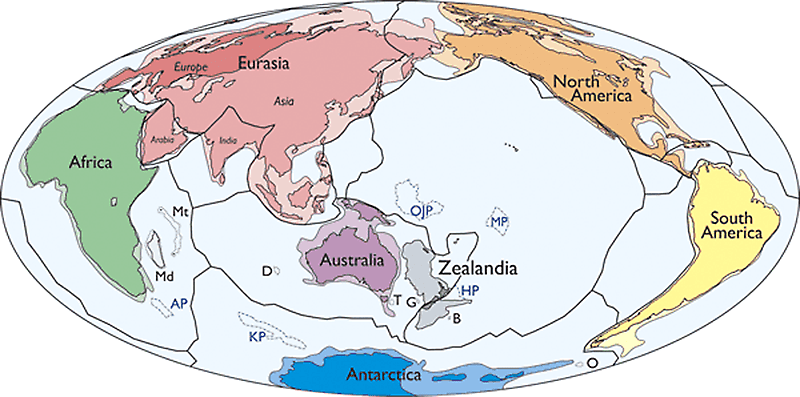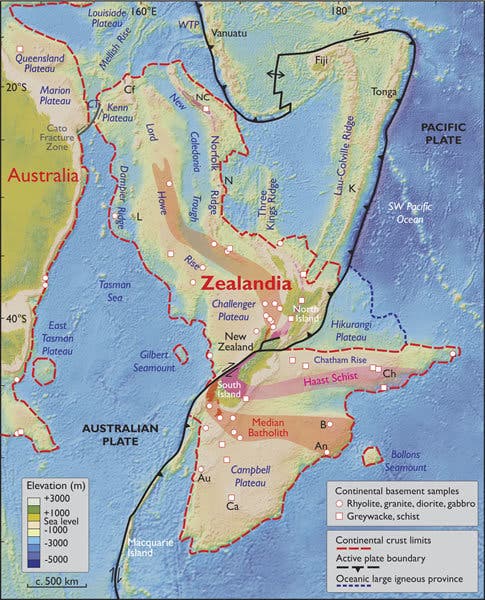
You might not even raise an eyebrow when scientists decide to demote Pluto’s status as a planet for very objective reasons or when astronomers propose there might be other planets lurking inside our solar system but yet to be identified. But to discover a new continent in the 21st century? Did it pop up overnight? “This is not a sudden discovery, but a gradual realization,” wrote the 11 geologists in a paper published in GSA Today which identified a seventh geological continent called ‘Zealandia’.
The researchers claim that New Zealand and New Caledonia aren’t just some islands chains — they’re just 5 percent of what’s visible above the ocean’s surface, the rest of the 5-million-square-kilometer continent being submerged under water. That makes Zealandia about as big as greater India. What’s more ten of billions of dollars worth of fossil fuels might lie off its coast.
Until now, there were ‘only’ six recognized geological continents: Africa, Antarctica, Australia, Eurasia, North America, and South America. Zealandia would be the seventh but also the ‘youngest, thinnest, and most submerged’ of the continents.’
The number of continents has changed throughout the evolution of the Earth. We have plate tectonics and continental drift for the constant tug of war that led to changes in the continental composition. The planet began with one single landmass in the Mesozoic Era but it has since gone through various stages of different supercontinents and continents.
So, how did we miss it? First of all, it’s nice to define what criteria makes for a continent. According to Business Insider, a continent has to fulfill all of the following:
- Land that pokes up relatively high from the ocean floor.
- A diversity of three types of rocks: igneous (spewed by volcanoes), metamorphic (altered by heat/pressure), and sedimentary (made by erosion).
- A thicker, less dense section of crust compared with surrounding ocean floor.
- “Well-defined limits around a large enough area to be considered a continent rather than a microcontinent or continental fragment.”
Both New Zealand and New Caledonia fit these criteria but up until now, it was obvious that #4 didn’t fit. But twenty years worth of state of the art satellite imagery suggests that these islands are in fact connected by a submerged continental crust, which is separate and distinct from Australia and Antarctica. Hence, Zealandia is a unified region.
“Zealandia illustrates that the large and the obvious in natural science can be overlooked,” the researchers say in the conclusion of their study. “Based on various lines of geological and geophysical evidence, particularly those accumulated in the last two decades… Zealandia is not a collection of partly submerged continental fragments but is a coherent 4.9 Mkm2 continent.”
“The scientific value of classifying Zealandia as a continent is much more than just an extra name on a list,” they wrote.
“That a continent can be so submerged yet unfragmented makes it [useful]…in exploring the cohesion and breakup of continental crust.”

Zealandia itself isn’t something new. It was coined by one of the authors of the new paper, Bruce Luyendyk, a geophysicist at the University of California at Santa Barbara, back in 1995. However, originally, Zealandia was used to describe New Zealand, New Caledonia, and a collection of submerged pieces and slices of crust that broke off a region of Gondwana, the supercontinent from 200 million years ago. Now, Luyendyk and colleagues propose that Zealandia is a distinct geological continent in its own right.
“If we could pull the plug on the oceans, it would be clear to everybody that we have mountain chains and a big, high-standing continent,” Lead author Nick Mortimer said.
There’s nothing settled, however. There’s no committee or official abled body that is tasked with deciding what and what not constitutes a continent like the one that demoted Pluto’s status as a planet, for instance. Instead, it’s more or less arbitrary (and obvious for the rest of the continents). Seeing how most of Zealandia is underwater, it will be very difficult to cement its new status in the eye of the public.
“What we hope is that Zealandia will appear on world maps, in schools, everywhere,” Mortimer said.
“I think the revelation of a new continent is pretty exciting,” he added.


